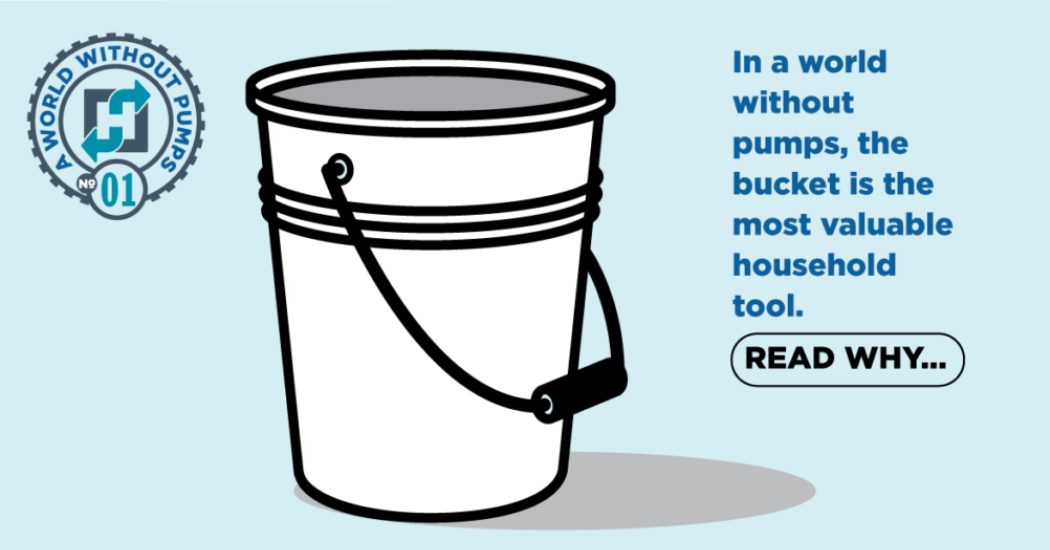Pumps are among the least recognized, yet most important elements associated with how we live today and where we live. Pumps are everywhere and Hydraulic Institute‘s World Without Pumps series will highlight aspects of everyday life today that would be completely different if pumps didn’t exist.
Besides helping to manufacture some of our favorite edible treats (think ice cream!), pumps are used in many everyday applications, from medical to entertainment and everything in between. Think of a what these settings would be like without pumps: adventure parks, swimming pools, chocolate production, automobiles, boats. Pumps are also used for irrigation, water supply, gasoline supply, refrigeration, mining, sewage movement, flood control, marine services, and many more.
Food-grade pumps, for instance, are built with attention to the materials and are easy to clean and sanitize. Without these we would not have efficient production and packaging of many of the foods we enjoy. Pharmaceutical pumps enable the manufacture of medicine, and there are even pumps used for daily life. Some pumps transport waste to a sewer, others are made exclusively for drinking water. There are pumps used to extract oil from the ground, and pumps are used for processing liquids. There are even pumps in your car meant to facilitate water cooling and power steering. With all that said, these pumps all have a practical purpose, and while their use is mostly behind the scenes, their importance today cannot be understated.
We may be biased, but we believe that pumps are one of the most crucial pieces of equipment running the world as we know it. We’ve developed this series, A World Without Pumps, to highlight the important, yet often overlooked, impact of pumps in society.
Today, we look at pumps in the home, and where we might live without them.
For starters, we wouldn’t likely be living in urban or suburban homes or apartments as we know them. Instead, it’s likely that we’d be living in single-story rooms by a river. Not the modern, expensive riverfront real estate by the water, mind you, but more along the lines of what you might remember seeing in old cowboy “spaghetti western” movies.
We use pumps to enable our sinks to work, our toilets to flush and our showers to run. Without these essential items we would be heading back in time more than 100 years.
From a plumbing perspective, today’s homes feature three primary types of pumps: sump pumps, sewage pumps, and well pumps.
Sump Pumps
Sump pumps remove water that collects at low points from around a home’s foundation. A sump is a constructed pit, usually a hole carved below the main surface of your basement floor where water from the ground collects. This pit, known as a basin, holds the sump pump, which is designed to be submerged. The pump is equipped to sense escalating water levels. When the water gets too high, the sump pumps automatically turns on to pump excess water out of the basement and away from the property. This discharge line connects the sump pump to a designated drainage area.
Sump pump water discharges to a designated area or drain. Ideally, discharge is kept 10 to 20 feet away from the foundation of the home, otherwise, the water could return to the home. Some cities have building codes that determine where the sump pump can drain. Without these pumps, many modern homes would not be able to have finished basements or locate any other home systems in the basement.
Sewage Pumps
Sewage pumps are used to transfer waste liquid and solids from one place to another. Usually, in residential settings, sewage includes soft solids which are pumped from a sewage basin to a pressure sewer system or a septic tank. Similar to the sump pump, a sewage pump is installed submerged in a collection basin at a low point and senses the level in basin which turns the pump on and off accordingly.
There are several types of sewage pumps: effluent pumps, solid handling pumps, and grinder pumps.
Effluent pumps are the pumps most often used in small on-site system. Effluent is relatively clear waste liquid where solids have been separated out. Effluent pumps can have tighter clearances and be more efficient than other types of sewage pumps because these pumps don’t have to handle large solids.
Solid handling pumps, are made to pump raw sewage. These pumps are designed with attention to clogging, with larger passageways. Raw sewage contains too many solids for pumps not designed for the service and they would clog quickly and stop working.
Grinder Pumps are like solid-handling pumps. That is, they can pump raw sewage. The difference is that the grinder pump has rotating blades, like garbage grinders that cut and grind the solids into small particles before the sewage is pumped.
Owners should be cautioned that even though solids handling pumps and grinder pumps are specifically designed for the service there are waste items that can clog them. One current issue are “flushable wipes”. These wipes are designed to breakdown in the system, but that does not always occur, and additionally confusion occurs and “non-flushable” wipes often get flushed. These wipes tend to group together and commonly clog pumps and sewage systems. Unless you want to have a frequent relationship with your plumber, it is best not to flush anything but toilet paper!
Well Pumps
The well pump is installed after drilling or digging a well. Its purpose is to pump the ground water from your well into your house. They can be surface pumps for shallow wells or submersible vertical turbine type pumps for deep wells. An electric motor drives one or multiple impellers, which pushes water from your well and into the home.
There are shallow-well and deep-well pumps. Both surface centrifugal and jet pumps are used to pump water from shallow wells (those that are 7 meters [25 feet] or less in depth). Multi-stage submersible vertical turbine pumps are typically used for deep-well applications (from just over 7 meters [25 feet] to over 100 meters [several hundred feet] deep), but jet pumps can be used depending on the depth. Submersible pumps vertical turbine pumps have both the motor and pump below the water level in the well, and they’re powered through an insulated wire running to the surface. About 60 percent of domestic home wells in the United States use submersible pumps.
There are many other types of pumps, of course, that make home life a lot more comfortable for us today. They are included in many appliances such as dishwashers and single serve coffee makers. Three other common conveniences that pumps provide is geothermal heating and cooling, hydronic heating, and hot water recirculation pumps. Geothermal pumps harness energy in the ground and either warm or cool air in your home. Utilizing the geothermal energy allows homeowners to save on heating and cooling costs. Hydronic heating circulator pumps deliver hot water to our radiators and back to the boiler, which provides even heating to areas of the home. Hot water recirculation pumps circulate water through a hot water loop so that when you open the hot water faucet gallons of previously warm (but now cold) water don’t run out prior to the hot water arriving. The hot water recirculation pump loop can save homeowners energy consumption by reducing the waste of heated water.
Hydraulic Institute has touched on several pumps that make living at home a lot easier than living in a van down by the river, as Chris Farley’s Saturday Night Live character, Matt Foley, might say. A house without pumps? Fortunately, we don’t even have to think about it.




